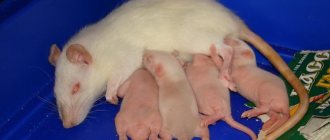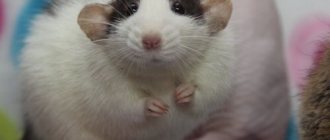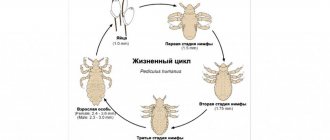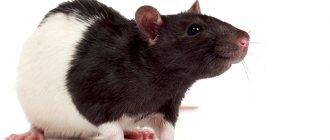Rats are intelligent, affectionate and playful companion animals. And if you've never owned a rat before, you might be wondering what their lifespan is.
Choosing a healthy pet rat and providing it with proper care and nutrition throughout its life can go a long way in extending its life.
What determines the lifespan of a rodent?
- Pedigree of the rat.
An inexperienced breeder may cross-breed sick animals and pass on undesirable traits to the baby rat, such as an inherited health condition, along with a certain color or coat pattern.
The optimal age for purchasing pet rats is about 6 weeks. Look for a healthy rat with shiny fur and lively eyes. Healthy rodents should also be active and inquisitive.
The rat you choose should not be sneezing, have a runny nose or red eyes. And you should make sure that the rat's droppings are dark and hard.
- Rat nutrition throughout life.
A rich diet for your pet rat is a guarantee of a long and happy life. Make sure she eats food specifically made for rats, and be aware of which human foods are safe to eat as rodent treats and which are toxic.
Type of rat by type of build
At the moment, only three types of rat build can be distinguished. The first and most common type of rat is the Standard. Their body is more elongated, and they have a very long tail, about 20 cm. Their weight can reach up to 0.5 kg, and they can reach a length of up to 25 cm. Ordinary rats have an elongated muzzle and round ears on the top of their heads. And their fur is very smooth and shiny, and it fits very tightly to the body.
The most common type of rat is the standard one.
Dumbo is the next species of rodent. This species differs from standard rats in the shape of its ears. Their ears are not on the top of the head, but on the sides, a bit like the shape of the ears of elephants. Due to this arrangement of the ears, their head appears wider. Otherwise, the back of their head may be slightly convex. Dumbo's ears themselves are very large and open, the upper part of the auricle is slightly curved. The body of this species is wider, so it slightly resembles the shape of a pear.
Adorable rat - Dumbo.
A rat without a tail, or in other words, a Manx. This species of rodent lacks a tail, and as is known, they need the tail to balance and cool the body. Rats that lack a tail otherwise have problems with the genitourinary system and problems with their legs. There is a risk that a pregnant female may give birth to dead cubs. There have been cases when sellers from pet stores or from various websites sold ordinary rats under the guise of Manx. The body of these rodents is not so elongated, but more similar to the previous type of rodent, Dumbo.
She looks cute, but there are so many problems with her.
How to extend the life of a pet?
Once you bring your new rat home, how do you ensure it has a long, healthy life? This can be done with the right diet. Here are some tips from nutrition experts:
- Plan your rat's diet. Like other pets, rats that are fed large portions of junk food can become obese. Even a small reduction in food intake can significantly increase the number of years your pet will live and improve its overall health.
- Feed your rodent food rich in antioxidants. As in humans, oxidative stress caused by free radicals in the body can cause disease and accelerate the aging process.
- Provide your rat with fresh vegetables such as carrots, broccoli and peas. Be sure to feed your pet food designed for rats and not other small rodents, as each animal has different nutritional needs.
- You can feed your rats fresh fruit from time to time. Rats also enjoy foods such as bread, nuts and boiled eggs.
However, save these foods for special occasions, as too many treats contribute to unhealthy weight gain. Additionally, a diet high in sugar and fat is unhealthy for a rat and can lead to health problems, just like in humans.
How to increase your life expectancy
The lifespan of pet rats depends not only on genetics and diseases. You can extend the life of a fluffy by creating ideal conditions for him.
Nutrition
For normal growth and development, your pet needs a balanced diet. 80% of the animal’s diet should consist of cereals. The most useful are corn, oats, wheat, rice, barley, and buckwheat. The remaining 20% accounts for the share of fruits, dried fruits, vegetables, nuts, and herbs.
There should always be fresh water in the animal's drinking bowl. During the period of intensive growth, the rat needs protein. Therefore, the rodent is allowed to give a little boiled lean meat (chicken breasts, rabbit, turkey) and hard-boiled eggs.
Fried and fatty foods, sweets, cakes, pastries, white bread, fast food, as well as salads, soups and other ready-made dishes are prohibited. Such treats will not only be of no benefit, but will also shorten the rat’s lifespan.
Dental health
The health of the rat’s entire body directly depends on the health of its teeth. Therefore, they must be carefully looked after. To avoid dental problems, it is enough to place a piece of chalk or a strong branch in the cage. The pet will be happy to sharpen its teeth on them.
Conditions of detention
The pet’s well-being, and therefore its health, including psychological, directly depends on the conditions of detention. To make your rat feel comfortable, you will need:
- Buy a spacious cage with metal rods . Inside there must be a drinking bowl, a feeding trough, a shelter house, a sleeping place and sports equipment (wheels, ladders, labyrinths, tunnels). Read the full list of what you can buy for a rat here.
- Create appropriate environmental conditions . The room with the cage should be cool. Ideal temperature is +18-20°C. You also need to make sure that the rat is not exposed to sunlight. Additionally, you should protect your fluffy from loud sounds, strong odors, and the sudden invasion of strangers or animals into the room.
- Buy a companion for your rat . Living alone greatly depresses the nervous system of rodents. It is better to choose a same-sex animal as a cagemate. Since bearing cubs and frequent childbirth negatively affects the health of females and significantly reduces their life expectancy.
- Periodically walk the animal in the fresh air . This will improve his mood and also strengthen his immune system. Only all walks should be under close supervision.
Another important condition is the unconditional love of the owner. Only by completely trusting a person will a pet rat feel safe, which will have a beneficial effect on its psycho-emotional background.
Cleaning and cleanliness in the cage
Cleanliness is the key to health. Therefore, the bedding in the cage needs to be changed as it gets dirty - 1-2 times a week. The animal's dishes must be washed thoroughly every day. Leftover food should be removed 20-30 minutes after the start of the meal to avoid poisoning. And once a month it is necessary to carry out complete disinfection inside the home.
The rodent itself also needs to be bathed periodically. Rats love water very much. The bath can be organized using any shallow container so that the liquid does not cover the pet’s head. For convenience, you can put a small wooden raft in the bath, which the fluffy will happily climb on. It should be taken into account that the water should not be hot, and for hygiene procedures it is better to buy specialized products at a pet store.
Diseases of domestic rats that most often kill rodents
- Respiratory diseases.
This is the most common health problem in rats. Pay attention to discharge from the eyes and nose, as well as sneezing.
Most respiratory infections are bacterial and can be treated with antibiotics. Viral infections require good supportive care such as a good diet and proper cage conditions.
To prevent respiratory infections, the rat's cage should be kept clean and well ventilated.
- Cancer.
Fortunately, most tumors in pets are benign. Cancer is more common in female rats. It usually appears on the mammary glands from 18 months of age, as this is when female rats stop ovulating.
If you feel any lump under your pet's skin, contact your veterinarian. There are various treatment options, including surgery, to remove the tumor.
- Skin parasites.
Rats are most susceptible to skin mites. The prevalence of skin mites can range from a few to a complete infestation.
A few mites are common on most rats and are not a problem. However, if a pet is stressed or sick, it is vulnerable to developing an infestation. This can be treated with medication. But prevention is always better.
The rat's cage should be kept clean and disinfected frequently to prevent mites. Additionally, you should feed your pet a proper nutritious rat diet and try to prevent them from becoming stressed.
Rodent character
Those who have never met a rat face to face before can argue that rodents have a bad character. And only the owners of tailed sneaks can say with confidence: this is a loyal and intelligent pet . In terms of intelligence, ornamental rodents are compared to dogs. And for good reason: these are very smart animals.
Each of the domestic rats has a special temperament. You will never meet two identical eared ones. There are homebodies who like to sit in a cage and sleep all day long. Travelers also meet: do not feed such a pet bread, let him walk around the apartment. There are also “revolutionaries”: when they get free (on the carpet, for example), they strive to turn everything in their own way, steal small objects and carry trinkets from place to place.
The rat is an animal that can smile sincerely . Of course, its smile bears little resemblance to a human’s, but scientists have proven that by showing its lower teeth, the rodent expresses its joy at meeting you.
It is also curious that rodents readily respond to their own name. If a mouse gets lost in the bowels of the apartment, you don’t have to rummage through all the closets in search of it (as, for example, in the case of a selfish hamster). Calling the tailed one by name, you will immediately see its ubiquitous face. After all, communication with your beloved owner is more important than any intrigues.
And rats love to communicate . For her, there is nothing so much adored as “her” person. The rat will choose as its “own” the one who will pay it the most attention. She won’t offend the rest of the family, but she won’t give her a championship medal either.
By the way, adult pets treat strangers with caution. You may not recognize your polite mustachioed friend when he grabs the finger of a curious guest. Rats are terribly loyal and devoted, and in the event of a change of owner they do not even try to get used to a new person, often remaining an “abandoned loner” until their death.
Care and maintenance of domestic rats.
When examining a rat's character, the future owner can be given some advice:
- When buying a pet, be prepared to interact with it daily. Communication involves contact, play and hand feeding. This is the only way your “mouse” will be happy. Let your pet sit on your shoulder, lightly tease you, and steal small trinkets from you.
- Introduce your pet to all family members right away so that there are no misunderstandings later.
- Give your rat a name and speak to it often. The smart rodent remembers not only some words, but also perfectly captures the mood by the intonation of its voice.
- Equip the “hole” according to all the rules (they will be described below). This way you will avoid the animal’s constant attempts to escape from the cage. A rat, in love with its home, will happily return there after a walk.
- As you already understand, walks are mandatory for a rodent. Of course, you don't have to take your rat to the park. It is enough to let her out of the cage once a day. If you have a female, then it is not recommended to leave her unattended. The girls are very homely and their whole life consists of trying to “build” a nest. The material for the kennel will be your personal belongings, so keep a close eye on your pet if you are not ready to sacrifice socks as building material.
How do the life spans of different breeds of rats differ?
Regardless of whether we consider the lifespan of Dumbo or Albino rodents, it is almost always the same. Rats typically live between 2 and 3 years.
- Dumbo. The normal lifespan of a healthy dumbo rodent should be 2 to 3 years or more. The main cause of disease or shorter life span is inbreeding.
- Sphinx. Unfortunately, hairless rats have many more health problems than their furry counterparts. Hairless rats not only lack fur, but also the thymus gland. Iron necessary for the development of the immune system. Therefore, they have a shorter lifespan than regular pet rats, ranging from 6 to 12 months.
- Albino (white rat). Although hairless rats do not live as long, fur color and markings do not affect its overall lifespan. Rats of any color, including albinos, can live long enough without problems if they are bred by a conscientious breeder and properly cared for by the owner.
Link to genetics and breed
Before answering the question of how many years do domestic rats live, the veterinarian pays attention to the breed data. On average, the life cycle of pets lasts 3-4 years. The figure may vary depending on many factors.
Decorative rats have many advantages:
- Rodents are completely devoid of aggression. This is due to their contact with people from the first days of life.
- Pets do not cause unnecessary discomfort because, unlike their wild counterparts, they do not hunt, but sleep at night.
- Domesticated representatives live much longer than street rats.
The lifespan of a rat is highly dependent on genetic factors. It is advisable to purchase a new family member from a trusted supplier. In the future, everything will depend only on care and breed data.
Most often, those who want to have a pet are interested in how long rats without fur - sphinxes - live. They are very different from their decorative counterparts. Rodents do not have hair. Can easily damage skin. Early mortality among this breed is high. Usually animals die at the age of 2-2.5 years. With improper care, the risk of developing various diseases increases.
Another common species is the tailless rat. Zoologists say that the tail of rodents performs an important function. It is a thermostat. Pets bred artificially and without a tail live for a maximum of 2 years.
It is believed that white rats are rodents that are most strongly attached to humans. The species has many subspecies. Pets of this group have weak protective functions. As a rule, they live at home for no more than a year and a half. In rare cases, their life cycle is 2-3 years.
How long do rodents live in the wild?
Rats in the wild are usually black or brown. But people began to catch white (albino) rats born from ordinary wild rats and keep them as pets. Many wild rats do not live to see their first birthday. Rats typically live between 6 and 11 months in the wild.
Rats in the wild face many more dangers than domesticated rats. They often become prey for many predators. Feral rats are also affected by food shortages.
Given these threats, it is not surprising that wild rats do not live very long.
How long do rats live at home?
Most often, pet rats stay with their owner for 2 to 3 years. This is 1.5–2.5 years more than a wild rat can live.
Because they live indoors, pet rodents are less vulnerable to both predators and food shortages. With a caring owner, pet rats can also receive veterinary care when signs of illness appear.
All these factors allow rodents to live for many years.
Wild rats
Wild rats are often called pasuks and they represent mammalian animals belonging to the order of rodents. These animals can be found anywhere in the world, with the exception of Antarctica. Pasyuks settled all over the planet several centuries ago during the period when people on ships began to explore new continents.
This rodent is distinguished by its gray fur, strong hind legs, sharp teeth that can handle almost any material, as well as the presence of intelligence. An adult rat can weigh almost half a kilogram and have a body up to 25 cm long, while the tail itself can be about 20 cm long.
When in the wild, pasyuki prefer to settle in areas where there is free access to water. These can be either single individuals or entire groups. As a rule, most of them prefer to live near a person, since food can always be found here. For rats living in basements, trash bins and other places located outside populated areas, life expectancy is no more than one and a half years, although some individuals live up to 3 years.
It is important to know! For many centuries, wild rats posed a huge danger to people, as they caused epidemics of various diseases that killed hundreds of thousands of people. Often, entire settlements died out from typhoid, fever and black plague.
The diet of a wild rat consists of:
- From small animals such as fish, frogs, mice, shellfish.
- From food items of plant origin, such as seeds and grains.
- From food items that rats find in landfills and garbage cans.
The lifespan of a wild rat depends on their species, diet, the presence of natural enemies, as well as human activity aimed at combating rodents.
Rats living in natural conditions reproduce no more than 2 times a year, which cannot be said about rodents that live in urban environments, where the food situation is more stable, and can reproduce up to 8 times a year. Moreover, each time they can produce up to 20 babies (maximum). Naturally, not all survive, since weak individuals die immediately, and part of the brood is eaten by the parents themselves. After birth, at the age of 4 months, young animals can reproduce.
Interesting fact! According to scientists, there are exactly 2 times more rats on earth in relation to the number of people. Moreover, in large cities their number is equal to the number of residents of megacities.











